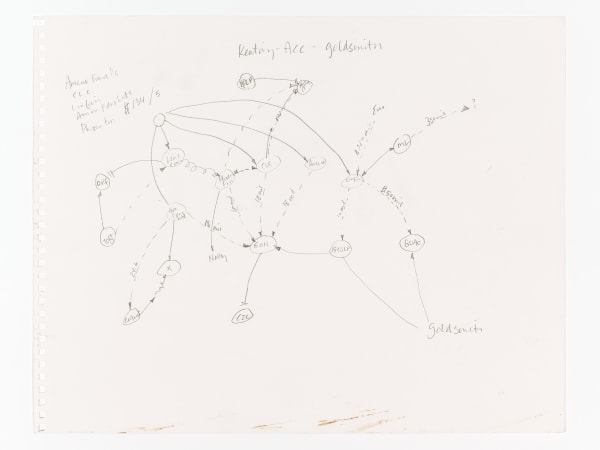YOU DON´T NEED A WEATHERMAN: GROUP SHOW
-
Introduction
The starting point for the artists featured in You Don’t Need a Weatherman are investigations aimed at revealing social dynamics, economic systems, and political relations within an increasingly complex world of virtual representation, infinite sources of information, and invisible data flows. They do this through various artistic approaches organizing readily available information and footage creating new narratives, systems, and structures.
Throughout his career, Iñigo Manglano-Ovalle has often addressed scientific themes in which unpredictability and chance especially in relation to climate, play an important role. In You Don’t Need a Weatherman (2006) Manglano-Ovalle combines diverse elements to create an impression of our own changing and apparently real climate. The work consists of a computer connected to a flat screen and a weather station. The installation appears as a live broadcast: the video image is composed by a computer program, which receives data from the weather station constantly altering the image. The lyrics of a Bob Dylan song from 1965, Subterranean Homesick Blues are superimposed on the image moving from left to right like a news ticker. Its most famous line You don’t need a weatherman, serves as both title of the installation and the exhibition.
British artist Stephen Willats uses the diagram as a tool to illustrate social interactions. Since the nineteen-sixties Willats has developed graphic visualizations in order to describe dynamic information flows as well as social relations and systems. Simultaneously, the artist manages to find ways to visually represent new philosophical and social ideas. As part of the exhibition, Willats contributes his wall work Orientation Drawing (1968) as well as the two videos Workers Paradise Essen (2001), in which the artist explores public housing projects for workers and visually associates objects and symbols found within the environment.
The three large photographic prints Belvedere I, V, and VI form part of a series of photographs, which David Hartt took at the Mackinac Center for Public Policy in Midland, Michigan in 2008. The series represents a continuation of Hartt’s investigation into what the artist calls vernacular utopias; “places where the ideal has been forced to morph and adjust to the reality of the surrounding imperfect world”. The on a formal level quite austere photographs provide an insight into the offices of the Mackinac Center, which is a conservative think tank, promoter of the free market, lower taxes, reduced regulation, and economic privatization, and place of origin of the so-called Overton window. The Overton window is an approach to identify which ideas define the domain of acceptability within a democracy’s possible governmental policies and is used by proponents of policies outside the window to educate the public in order to shift or expand the window. This policy framing device is alluded to through the ironic title Belvedere (from Italian for fair view), a reference to the Renaissance practice of using an architectural device to frame and order the natural environment.
Most recently, the impressive sociograms by the American artist Mark Lombardi were featured in the last documenta. In the nineteen-nineties, he began his work on his Narrative Structures, in which the artist visualized the connections between individuals, institutions, banks, businesses, and governments in detailed, mind map-like drawings. In preparation for this, Lombardi incessantly read newspapers, books, and went through countless politically-themed sources, tracing networks and coteries. Lombardi’s sociograms were executed so precisely that today they are considered to be both unique historic works of art as well as being responsible for bringing to light scandals, such as the questionable career of George W. Bush and his ties with Harken Energy.
The installation props by Julian Irlinger consists of lenticular prints installed on the uncladded frame of a drywall construction positioned diagonally to the exhibition space. The lenticular prints depict parts of the artificially planted Garden Court of the Frick Collection in New York. This courtyard with its overarching glass ceiling is considered a key element of the transformation of the villa into a public museum by the industrialist Henry Clay Frick. The footage for the lenticular prints props was captured by Irlinger from online museum tours. Irlinger’s props each present two different (re-)presentations of the same interior. The images originate from the Frick Collection own virtual tour and the tour produced by the Google Cultural Institute. The artist isolates images from the immersive photographic arrangements from both virtual tours. Depending on the viewing angle, the layered images of the lenticular print gradually alternate thus making it impossible to define a single ideal viewing position. The beholder’s gradual movement in analog space stands opposed to the quick accessibility and consumption of image circulation on the internet. Through the juxtaposition different versions of image reproduction, which are the results of varying economic interests, are revealed.
Finding Chopin: Dans l’Essex, (2015) was shot by Tris Vonna-Michell on 16mm film during a residency in Montreal in order to document the artist’s exhibition Finding Chopin, which took place in the same city around the same time. Finding Chopin since 2005 has been an ongoing project and series of performances around the artist’s research into the life of the French concrete and sound poet Henri Chopin (1922–2008) and pans between historical events and personal anecdotes. Chopin lived in Vonna-Michell’s hometown of Leigh-on-Sea in Essex, England, between 1968 and 1986, and created a large body of pioneering recordings using early tape recorders, studio technologies, and sounds of the manipulated human voice. Vonna-Michell layers and renegotiates the inherent form and material of narrative structures, to arrive at what the artist calls a “narrative of form”. Multiple facets defy conventions and reflect on the possibility of recording and transmitting history, tracing the associative complexities of how histories and rumors are told. -
Works
-
Installation Views
-
Inquire about "You don't need a weatherman"

-
Artists on view

































